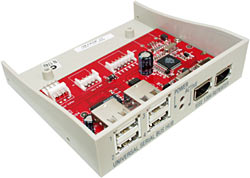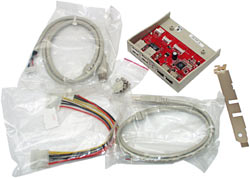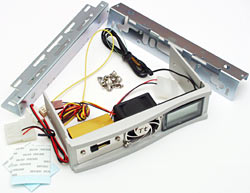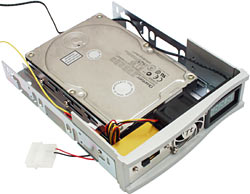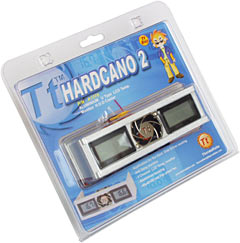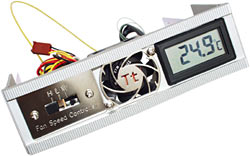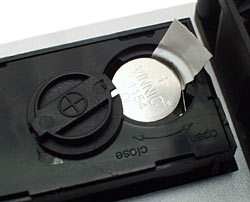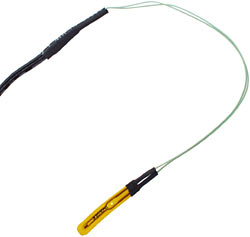
USB/FireWire internal hub and Thermaltake HardCano II and III
Review date: 22 April 2002.Last modified 03-Dec-2011.
There seem to be two basic schools of thought about what kind of PC case looks good.
The first school likes it clean. Flat, featureless panels. Floppy and CD-ROM drives that you can't even see. One small light for power. One small light for drive activity. A couple of understated buttons. That's it.
The second school like the front of their computer to look like a time machine control panel. Buttons! Knobs! Switches! Lights! Displays! Crank handles! Cigarette lighters!
There are other schools of thought as well, but we won't let them concern us right now.
If you find yourself drawn to the second school of thought, then a drive bay with nothing in it is anathema.
You can try filling all of your bays with actual regular drives, of course. A vanilla PC case is only likely to have three 5.25 inch bays, and so a DVD-ROM, a CD-ROM and a CD-RW drive will plug 'em all and give you the ability to keep multiple copy-protected game CDs on hand at once, or what have you. Filling spare front-accessible 3.5 inch bays is trickier - how many floppy drives do you need, after all - but there's always internal Zip drives.
Where's the fun in that, though?
Accordingly, here are a couple more products that'll fill a bay in a less normal way.
First, the simple one.
This is a USB/FireWire internal hub. It's one of those generic products that's made who-knows-where and sold under no particular brand name. Aus PC Market here in Australia stock it (catalogue number CA-GECP132) for $AU71.50, including delivery.
That's not a bad price, if you actually need a product like this. You get a four port USB 1.1 hub and a two port FireWire (IEEE-1394) repeater, both of them are powered. And the whole assembly just screws into a 3.5 inch drive bay like a normal drive.
Four ports is the usual number for a USB hub; you only get three more than you had before, because you have to plug the hub into a port you've already got, but you'll still end up with enough for most applications.
A two port FireWire repeater (which fills the same basic role as a USB hub) will only give you one more port than you had before, but that's also likely to be adequate. You probably don't have a whole lot of FireWire gear that you want to plug in at once, and some FireWire devices have passthrough ports, anyway. Just moving the ports to the front of the computer is likely to be a worthwhile advantage, if you're plugging and unplugging devices often.
The bay-hub kit gives you all of the cables you'll need. The hub gets power from a normal 3.5 inch drive power receptacle, and comes with a passthrough power Y-adapter that'll let you plug it in even if all of your PSU plugs are in use. And there are two data cables, and a back panel blank with matching slots.
These last items give away the fact that this product hasn't found a new solution for the problem that all internal USB hubs have.
USB ports, you see, are on the outside of computers. So to plug an internal hub into them, you need a cable that exits the computer at the back, to plug into one of the rear ports.
That said, this hub does the job as neatly as any I've seen. The two loopback cables - one USB, one FireWire - have moulded-in slotted grommets towards the end, which fit neatly into the slots on the provided back-plate panel. So the cables won't chafe. And you won't need to loop the FireWire cable outside the computer at all, if you're using a FireWire adapter card that's got one or more free internal ports, as many of them do.
If all you need is a USB hub, you can get both internal and external ones for less than this thing costs. And if you want USB 2.0 compatibility, this hub doesn't have it. Aus PC have both external and internal USB 2.0 hubs, by the way; their internal one is catalogue number NE-SKDB343, and costs $AU88 delivered.
If standard USB 1.1 plus FireWire is what you want, though, then this gadget provides both, at an OK price. And, of course, it makes the front of your computer more complicated.
And now, the other bay-occupier.
This is Thermaltake's HardCano III.
No, I don't know where they got the name.
Possibly from the same image-builders who provided them with their cute little "TT Boy" mascot.
Let's just say that's not the name I would have chosen.
Anyway.
The HardCano III is a 5.25-to-3.5 inch drive mounting adapter with a speed controlled cooling fan and a separate temperature monitor. Its front panel's made of lightly sculpted matte silver cast aluminium; its side rails are steel.
The HardCano series currently has two other products in it. The HardCano II has two temperature displays and no fan speed control; the HardCano 5 is like the III, except fully enclosed.
The HardCano II is the only one that seems to have made it to retail, as I write this; it's selling for around the $US35 mark. I presume the III won't be much more expensive. The HardCano 5's extra metalwork will probably jack its price up a bit.
Drive adapter kits that let you mount a 3.5 inch drive in a 5.25 inch bay are common enough. Basic rails-only kits only cost a few bucks; full removable racks with flip-out handles that let you take the drive away or lock it in a safe can be had for less than the price of the HardCano II. Many of these products have one or more 40mm fan for cooling the drive. But this feature might as well not be there.
There are two reasons why 40mm fans for cooling hard drives are a waste of time.
One - most hard drives don't need special cooling. If you're running a 10,000RPM or faster SCSI drive then yes, that sucker needs some air moving past it or it'll bake itself in short order. And if your case ventilation is awful, your ambient temperature is very high, and/or you're mounting a stack of drives cheek-by-jowl, then it's also a good idea to direct a breeze over them.
But consumer 7200RPM ATA drives are designed to deal with high operating temperatures; it really isn't likely to matter much whether you give them special cooling or not, in most circumstances. Just mounting one in a 5.25 inch bay with a set of cheapo adapter rails should give it more than enough cooling; sticking fans in front of it as well is complete overkill.
The second reason why these little fans aren't much use is that they don't actually do very much.
ThermalTake claim a 5.1 cubic foot per minute air flow for the fan in the HardCano III, at full power. This is plausible enough, but it's not at all impressive. A low power 80mm 12 volt case fan can move well over 30 cubic feet per minute. 50CFM-plus ratings are common enough for somewhat noisier, but still not ridiculously powerful, 80mm fans.
Whether a fan will actually achieve something like its free-air flow rating when you install it in a given cooling system depends on how much flow resistance it's facing. But compared with the flow rate of the power supply exhaust fan and the front panel intake fan in an ordinary PC, the contribution of the HardCano fan is likely to be trivial.
Even three-fan hard drive coolers do little for the temperature of the drive behind the fans. You'll do better to install a second 80mm exhaust fan at the back of your case, thus creating a slight negative pressure inside the box, and then remove the fans from the hard drive cooler entirely. The rear fans should suck air in through the hole just fine.
Little teeny fans also have a tendency to not last very long. They have to spin pretty fast to achieve their miserable flow ratings; the one in the HardCano III has a 5000RPM rating from 12 volts. 5000RPM, cheap sleeve bearings, alleged life span 30,000 hours (three years, five months)... yeah, all right, maybe. And maybe not.
Which is where the speed control on the HardCano III comes in.
How do you make a weeny fan last longer? Run it slower.
This'll reduce its air flow even more, of course, but what the hey. It's already doing nothing in particular.
This speed controller has a three-position switch that lets you run a 12 volt fan at full voltage, or at about nine volts, or at about six volts - which means about 55% power, and about 25% power, for the two lower settings. The HardCano's own fan is quite quiet even at full speed; at the medium and low settings, it's practically inaudible, and will be drowned out easily by the average PSU exhaust fan.
The speed controller can do its trick regardless of the type of fan you connect to it, assuming you're not trying to run some monster UltraFan off it. This is because it uses Zener diodes to drop the voltage, not simple resistors.
This is, in fact, the same speed control that comes with Thermaltake's excellent Volcano 7+ CPU cooler, which I review here. And because it's got a plain four pin receptacle input and a plain three pin socket output (with a single-wire flylead that you can plug into a motherboard fan header for speed monitoring), you can connect this speed controller to any three-pin-plug fan in your case. The HardCano III even comes with a passthrough four-to-three-pin adapter lead, which lets you run the HardCano's own fan (at full speed) from your PSU, while you use the speed controller to control some other fan.
So there's that.
There's also the temperature monitor.
Like Lian Li's T-4 dual thermometer (which I review here), the HardCano temperature monitor is a separate battery-powered unit, which you could easily pop out of the panel if you wanted. As with the T-4, the thermometer comes with a little bit of plastic-paper stuff stopping its single button cell from making contact; pull the paper out and it starts working.
There's no on/off switch, so it'll keep monitoring temperature even when your computer's off. You may consider that to be a desirable feature, and you may not. It shouldn't hurt battery life much, mind you; these little thermometers draw a weeny fraction of a milliamp, so the battery should last longer than the one in a quartz watch. Quite a bit longer, probably, seeing as it's got a lot more capacity than the average watch battery.
The thermal probe wire is about a metre long, and the relatively chunky black insulation stops short of the end, which should make it easy for you to thread it into any tight spot inside your case. You still mustn't sandwich it in the contact patch between your processor and CPU cooler, because even a super-flat probe like this one's plenty thick enough to quite drastically foul up the thermal contact, but just about anywhere else should be doable. You get two square tape patches with the HardCano, for probe-attachment purposes.
The HardCano thermometer seems accurate enough; it matched the readings from my fairly-well-calibrated stand-alone dual-input digital thermometer at least as well as that thermometer's two inputs agreed with each other.
The HardCanos also come with sufficient screws to let you mount pretty much any 3.5 inch internal drive in it. The side rails have a plethora of cutouts and holes, so they should match various esoteric screw-hole configurations.
Assuming the HardCano III doesn't cost a lot more than the II, then it's not a bad product, assuming you've got a use for it. The fan's just tinsel, but the fan controller is still useful, and the thermometer does its job. I'd rather the thermometer had a PC PSU power connector and not a little battery that you'll eventually need to replace, but this isn't a major problem. And it does let you establish the ambient temperature, if you leave the PC off for long enough, or just route the temperature probe all the way out of the case.
The HardCano III also has the advantage that its cast front panel will look good installed in a silver aluminium PC case, which is more than can be said for the beige-fronted USB and FireWire hub. The HardCano wouldn't look too bad in a black case, either. If you're into haute couture computing, this may matter to you. It also puts the two-thermometer HardCano II ahead of the Lian Li T-4; that's got the same sorts of thermometers in it, but that's all it has; it's just a couple of thermometers on a panel. The Thermaltake product looks fine, and gives you a drive mount and fan into the bargain.
If your idea of the perfect computer case is a featureless cube with, perhaps, one small light and a button behind a seamless sliding panel, then none of these products will turn your crank.
Those who prefer a busier look, though, could well find a home for all of them.
Thermaltake's page for their hard drive coolers
Buy a hub!
Readers from Australia or New Zealand can purchase the internal USB/FireWire hub from Aus PC Market.
Click here!
(if you're NOT from Australia or New Zealand, Aus PC Market
won't deliver to you. If you're in the USA, try a price search at DealTime!)
